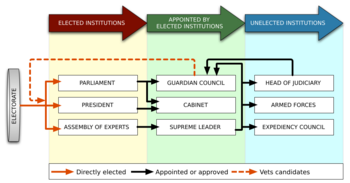Government of Iran facts for kids

|
|
| Formation | 1 April 1979 (Islamic Republic formed) 21 August 1980 (first Islamic Consultative Assembly session) |
|---|---|
| Founding document | Constitution of the Islamic Republic of Iran |
| Jurisdiction | Iran |
| Website | https://irangov.ir/ |
| Legislative branch | |
| Legislature | Islamic Consultative Assembly |
| Meeting place | Baharestan |
| Executive branch | |
| Leader | Supreme Leader (since 1979) President (since 1989) Prime Minister (1979–1989) |
| Appointer | Assembly of Experts (Supreme Leader) Direct popular vote (President) |
| Headquarters | Pasteur |
| Main organ | Cabinet |
| Departments | 19 Ministries |
| Judicial branch | |
| Court | Judicial system of the Islamic Republic of Iran |
| Seat | Courthouse of Tehran |
The Government of the Islamic Republic of Iran is the official political system in Iran. It has been in power since 1979, after the Iranian Revolution. This revolution led to the end of the old monarchy, the Pahlavi dynasty.
Iran's constitution was approved in 1979. It sets up a government with separate parts: the executive (like the President), the legislative (like the Parliament), and the judicial (the courts). The Supreme Leader of Iran is the country's top leader and the head of its armed forces. Iran is one of the few countries called an Islamic republic.
Contents
How Iran's Government Was Created
The Islamic Republic of Iran was formed right after the Iranian Revolution. Big protests against the Shah (the king) began in January 1978. These protests aimed to change the country's leadership.
The Shah left Iran in January 1979 because of widespread strikes and demonstrations. Soon after, Ayatollah Khomeini returned to Iran from exile. Millions of Iranians welcomed him in Tehran. The old government officially fell on February 11, 1979.
After the revolution, people voted in a special election in March 1979. They were asked if they wanted an Islamic Republic. The results were announced in April 1979. About 98% of Iranians voted "Yes" to create the Islamic Republic.
Iran's Constitution
The Constitution of the Islamic Republic of Iran was officially approved in December 1979. Almost all Iranian voters (99.5%) agreed to it. This constitution mixes religious rules with democratic ideas.
For example, it says that God has the highest power. But it also requires popular elections for the President and the Parliament. However, all democratic processes must follow the rules set by the Guardian Council and the Supreme Leader of Iran.
Main Ideas of the Government
The government of Iran is officially a theocratic republic. This means it is a republic (where people have power) but also guided by religious laws. The constitution explains that the system is based on belief in one God and the need to follow His commands.
It also emphasizes justice, human dignity, and freedom. The government aims to ensure fairness, independence, and national unity. This is done by following Islamic teachings and using modern knowledge. It also aims to stop all forms of unfairness and control.
How Iran's Government Works
Iran's government has several key parts that work together. These include the Supreme Leader, the Parliament, the President, and the courts. Each part has specific duties to help run the country.
The Supreme Leader

The Supreme Leader is the most powerful person in Iran. This position was created by the constitution. The Supreme Leader holds this job for life. They set the main policies for the country.
The Supreme Leader is also the commander of the armed forces. All parts of the government—the legislative, executive, and judicial—operate under the Supreme Leader's guidance. Iran has had two Supreme Leaders: Ayatollah Ruhollah Khomeini (1979-1989) and Ayatollah Ali Khamenei (since 1989).
Assembly of Experts
The Assembly of Experts is a group of 88 religious scholars. These members are chosen by public vote every eight years. Their main jobs are to elect the Supreme Leader and, if needed, to remove them from power.
The Legislature (Law-Making Body)
Iran's law-making body has two main parts: the Islamic Consultative Assembly and the Guardian Council. These two groups work together to create and approve laws for the country.
Islamic Consultative Assembly (Parliament)
The Islamic Consultative Assembly is like Iran's Parliament. Its members are directly elected by the people through secret ballot. This assembly can make laws on all matters, as long as they follow the constitution.
Currently, the Parliament has 290 members. This number can increase over time based on population and other factors.
Guardian Council
The Guardian Council is another important part of the legislature. It acts somewhat like an upper house to the Consultative Assembly. This council checks all new laws passed by the Consultative Assembly. They make sure these laws are compatible with Islamic law and the Constitution.
The Guardian Council has 12 members. Six are religious experts chosen by the Supreme Leader. The other six are legal experts chosen by the Parliament from a list provided by the Chief Justice.
The Executive (Running the Government)
The executive branch is responsible for carrying out the laws and managing the country. The President is the head of this branch.
The President
The President of Iran is the second most powerful person in the government. They are the head of the government and are elected by popular vote. However, the President reports to the Supreme Leader, who is the head of state.
The President's duties include signing agreements with other countries. They also manage national planning, the budget, and government jobs. The President appoints ministers, but these appointments must be approved by the Parliament. The President serves a four-year term and can serve a maximum of two terms in a row.
Vice President
The President also has several Vice Presidents who help with different tasks.
Cabinet
The Cabinet is a group of ministers chosen by the President. Each minister is in charge of a specific government department, like education or health.
The Judicial System (Courts)
The judicial system in Iran is independent. Its main job is to protect the rights of individuals and society. It is responsible for making sure justice is served.
The courts investigate complaints, resolve disputes, and make decisions in legal matters. They also work to restore public rights and promote justice. The judiciary supervises the proper enforcement of laws. It also aims to prevent crimes and help reform criminals.
Other Important Groups
Expediency Discernment Council
This council is a group of advisors chosen by the Supreme Leader. It was created to help resolve disagreements between the Parliament and the Guardian Council. Its main role is to advise the Supreme Leader on important issues. Members are chosen every five years.
Local Councils
Iran also has local councils in villages, cities, and provinces. These councils help manage local affairs like social, economic, and health programs. Members of these councils are elected by the people in their local area. They work to meet local needs and improve public welfare.
Islamic Republic of Iran Broadcasting (IRIB)
The IRIB is the only official radio and television service in Iran. The Supreme Leader appoints the head of this organization. A special council supervises its operations.
Iran's Armed Forces
Iran has several armed forces that protect the country. The Supreme Leader is the commander-in-chief of all these forces.
General Staff of Armed Forces
This is the highest military body in Iran. It helps carry out policies, monitors, and coordinates activities across all armed forces.
Islamic Republic of Iran Army
This is Iran's traditional military force. Its job is to protect Iran's independence and territory from threats. It includes ground forces, air force, navy, and air defense.
Islamic Revolution Guard Corps (Sepah)
The Sepah was formed after the Islamic Revolution. Its role is to protect the revolution and its achievements. It is a separate branch of Iran's armed forces.
Law Enforcement Force
This is Iran's uniformed police force. It was created in 1992 by combining different police groups. It includes police personnel and border patrol officers.
Images for kids
-
Joint Tripartite Meeting of Iranian Government, 2 June 1987. Speaker of the Parliament Hashemi Rafsanjani (left), President Ali Khamenei (middle) and Head of Supreme Court Mousavi Ardebili (right).
See also
- Ayatollah Ruhollah Khomeini
- Politics of Iran (links to ministries and government agencies)



